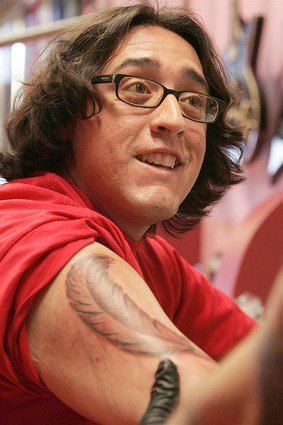It seems strange, at first blush, to be ashamed of a disease, especially a hereditary condition to which you may be genetically predisposed. Sure, if you eat like crap or are a furious chain-smoker, there may be parts of your life on which to look back and regret (not to say a person should feel shame about the resulting illness, of course), but to harbor those sorts of feelings because of an affliction caused by little more than dumb luck? Seems a little harsh.
 |
| Photo credit: Spencer Weiner / Los Angeles Times |
But consider the imposition rather than the disease itself — to have your life and livelihood restricted by a force out of your control, and to be inadvertently singled out among your peers as a result. So was the case for Joshua Sandoval, who was diagnosed with diabetes as a 12-year-old.
Says Sandoval:
Some kids pretend they don’t have diabetes, giving in to the temptation of sugar and refusing to exercise regularly or monitor their glucose levels. Some go to the other extreme, constantly checking glucose levels, exercising every day and openly discussing their disease.
I fell somewhere in the middle. I was obsessive when it came to checking glucose levels, and I stayed active in sports like baseball and basketball, but I was unwilling to discuss my illness.
His parents struggled to get him to embrace the imperfect part of himself, though, and, when he was 16, his mother gave him the idea of getting a tattoo as a way to own the disease and the rituals of a careful diet and daily injections that came along with it. Permanence in any respect can be daunting; it’s hard to fault someone for wavering when faced with the terms of a lifelong commitment, especially one that’s been decided for you. It’s not uncommon to see people get tattoos to commemorate challenging events — events some people would rather just forget — and Sandoval’s decision seems to follow that line of thinking: Combatting permanence with permanence, and turning a purveyor of shame into a source of pride.
Two weeks after the tattoo healed, I was in line at the post office when the pen tip crept out from a short-sleeved shirt. A woman standing in line with no visible artwork of her own asked to see the rest of the tattoo.
After she took a picture with her camera phone and commented about the detail in the feather, she asked about the tattoo’s significance.
For the first time in 10 years, my head didn’t slump between my shoulders.
A diabetic turns to the tattoo as medical I.D. [Los Angeles Times]
 BME/News and Modblog highlight only a small fraction of what
BME/News and Modblog highlight only a small fraction of what
It’s nice that tattoos are being brought into a more positive light nowadays.
just thought I would add that
It’s nice that tattoos are being brought into a more positive light nowadays.
just thought I would add that
I love this.
I love this.